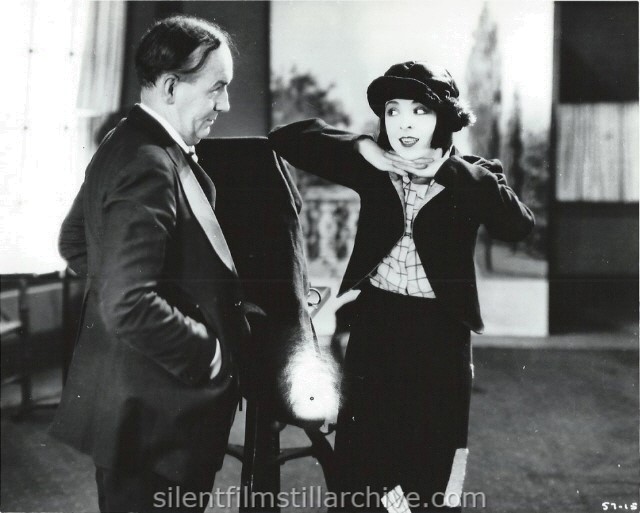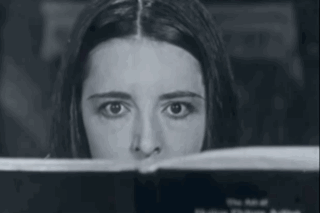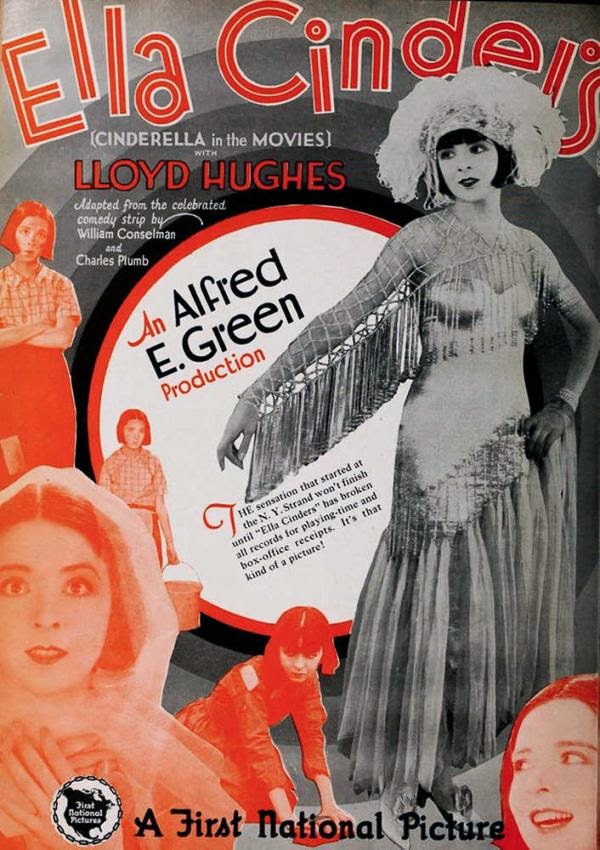Uma história tão velha quanto o tempo, mas não
é A Bela e a Fera. Hoje nosso assunto é Cinderela e todos os elementos
familiares que vêm com o conto de fadas: a Fada Madrinha, a abóbora que se
transforma em carruagem, o encantamento que acaba à meia-noite, o sapatinho de
cristal que é deixado para trás e que o Príncipe experimenta nas mulheres. Todos
estes elementos estavam lá quando Georges Méliès fez a primeira Cinderela do
cinema, em 1899. Eles estavam todos lá em 1914, quando Mary Pickford estrelou
sua própria versão adorável do conto. Mas a era do cinema mudo nem havia
chegado ao fim quando a história foi modernizada e subvertida no hilário filme “O
Prêmio de Beleza” (1926).
A tale as old as time, but not Beauty and the Beast. Today we talk about Cinderella and all the familiar bits that come in the story: the Fairy Godmother, the pumpkin that becomes a carriage, the enchantment that ends at midnight, the glass slipper lost and left for the Prince to try on the women. They were all there, when Georges Méliès did the first Cinderella in film history, in 1899. They were all there in 1914, when Mary Pickford starred in her own adorable version of the tale. But the silent film era wasn’t over yet when the story was modernized and subverted in the hilarious "Ella Cinders" (1926).
Na cidade de Roseville mora a família Cinder,
cuja filha adotiva Ella (Colleen Moore) faz todas as tarefas em casa. Quando
chega a notícia de que um concurso de beleza será feito na cidade, com o prêmio
sendo uma quantia em dinheiro e uma passagem para Hollywood, todas as garotas
ficam animadas, incluindo Ella. Ela economiza dinheiro para tirar uma foto para
o concurso, mas não tem roupa para ir ao baile onde a vencedora será anunciada.
In the city of Roseville live the Cinders, whose stepdaughter
Ella (Colleen Moore) does all the chores in her house. When news come that a
beauty contest is about to take place in town, with the prize being a sum of
money and a ticket to Hollywood, all girls get excited, including Ella. She
saves money to take a picture for the contest, but has no clothes to go to the
ball where the winner will be announced.
Ella só vai ao baile por insistência de seu
amigo Waite (Lloyd Hughes), vendedor de gelo. Lá ela é humilhada e deixa seu
sapatinho para trás. No dia seguinte, os jurados do concurso chegam à casa dos
Cinder procurando pela filha deles. Ella ganhara o concurso e o resto do filme
conta suas aventuras em Hollywood.
Ella only goes to the ball because of the insistence of her friend Waite (Lloyd Hughes), the iceman. There she is humiliated and leaves her shoe behind. The next day, the jurors of the contest arrive at the Cinders’ house in search for their daughter. Ella has won the contest and the remainder of the movie chronicles her misadventures in Hollywood.
A cena mais icônica do filme chega na marca de
10 minutos: Ella Cinders vesga lendo um livro que ela roubara da meio-irmã
Lotta (Doris Baker). De acordo com o IMDb, o truque foi feito de maneira até
fácil: um pedaço de papel preto foi colocado num lado da câmera e os movimentos
de olho foram filmados, depois o pedaço de papel passava para a outra metade da
câmera e o movimento do outro olho era filmado. Quando juntadas as partes, a
mágica acontecia.
The most iconic scene from the movie comes at the 10 minute mark: Ella Cinders cross-eyed over a book she had stolen from her stepsister Lotta (Doris Baker). According to IMDb, the trick was achieved in a rather easy way: a black piece of paper taped half of the camera and the eye movement was recorded, then the piece of paper was moved to the other half of the camera and the other eye movement was then filmed. When the scene played combining the parts, the magic happened.
O conto da Cinderela vem de um livro de 1697
publicado por Charles Perrault, mas a história não surgiu da cabeça dele. O
conto em si é muito antigo e passava de geração em geração, mas Perrault foi o
primeiro a compilar contos como este e também o pi0neiro em duas outras coisas:
chamar a personagem de Cinderela – no francês original, “Cendrillon” – e a
mencionar que ela estava usando um sapatinho de cristal – um calçado bem
desconfortável. Mas o filme não derivou diretamente do conto de fadas.
The tale of Cinderella came from a 1697 book released by Charles Perrault, but it didn’t come from his mind. The tale itself was very old and passed through several generations, but Perrault was the first to compile tales such as this one and also the first one to both name the character Cinderella – in the original French, “Cendrillon” – and to mention that she was wearing a glass slipper – a rather uncomfortable kind of footwear. But the movie didn’t come directly from the fairy tale.
“O Prêmio de Beleza” foi adaptado de uma
tirinha de jornal! A tirinha foi publicada entre 1925 e 1961 e foi criada por Charles
Plumb e William M. Conselman do departamento de arte do Los Angeles Times. Um
dos roteiristas responsáveis pela adaptação foi Mervin LeRoy, um ex-ator de
vaudeville que se tornaria um prolífico diretor em Hollywood. A principal
diferença das tirinhas para o filme é que nas tirinhas Ella tem um irmão mais
novo chamado Blackie, que não aparece no filme.
“Ella Cinders” was adapted from a comic strip! The strip was published from 1925 to 1961 in American newspapers and was created by Charles Plumb and William M. Conselman from the Los Angeles Times art department. One of the screenwriters responsible for the adaptation was Mervin LeRoy, a former vaudevillian who would become a prolific director in Hollywood. The main difference from the source material is that Ella has a kid brother, Blackie, in the comic strip that is totally absent from the movie.
“O Prêmio de Beleza” foi distribuído pela First
National Pictures, produtora e distribuidora que existiu em Holywood entre 1917
e 1936. O diretor é Alfred E. Green, que entrou no cinema como ator em 1912 e
dirigiu seu primeiro longa em 1917. Green também aparece em “O Prêmio de Beleza”,
interpretando um diretor no estúdio. Já que estamos falando de diretores,
devemos mencionar que Frank Capra dirigiu a breve sequência em que Harry
Langdon faz uma participação especial.
“Ella Cinders” was made by First National Pictures, a producing and distribution company that existed in Hollywood between 1917 and 1936. The director is Alfred E. Green, who entered films as an actor in 1912 and directed his first feature in 1917. Green also appears in “Ella Cinders”, playing a film director in the studio. Since we’re talking about directors, we should mention that Frank Capra directed the brief sequence with Harry Langdon’s cameo.
“O Prêmio de Beleza” é hoje o mais famoso filme
estrelando Colleen Moore. Com apenas 26 anos quando o filme foi rodado, Moore
já estava trabalhando no cinema desde os 18 e já havia influenciado milhões de “flappers”
a cortarem o cabelo igual ao dela. O produtor de “O Prêmio de Beleza”, John
McCormick, era marido de Moore na época, e Lloyd Hughes, que interpreta o par romântico,
já havia feito outros quatro filmes com Moore entre 1923 e 1926. Depois de uma
pausa na carreira quando o som chegou ao cinema, Moore fez seus últimos filmes
nos anos 1930, aposentando-se em 1934.
“Ella Cinders” is now the most famous movie starring Colleen Moore. Only 26 when the film was shot, Moore already had been working in films since she was 18 and had influenced millions of flappers to cut their hair like hers. The producer of “Ella Cinders”, John McCormick, was Moore’s husband at the time, and Lloyd Hughes, who plays the love interest, had appeared in four other films with Moore between 1923 and 1926. After a career pause when sound came to cinema, Moore made her final films in the early 1930s, retiring in 1934.
Em 2013, “O Prêmio de Beleza” foi selecionado
para ser preservado pela Biblioteca do Congresso norte-americano, em uma lista
chamada National Film Registry. A versão animada de “Cinderela”, feita por Walt
Disney em 1950, também foi selecionada para preservação. O conto foi adaptado
dezenas de vezes, mas “O Prêmio de Beleza” traz um retrato fresco da história
da moça pobre que triunfa e se mantém aprazível após quase um século de sua
estreia, em parte por causa da performance jovial de Colleen Moore como a sonhadora
Ella.
In 2013, “Ella Cinders” was selected to be preserved
by the Library of Congress in their National Film Registry. The animated
version of “Cinderella”, made by Walt Disney in 1950, is also in the Registry.
The tale was adapted to the screen dozens of times, but “Ella Cinders” brings a
fresh portrait of the rags-to-riches story and remains enjoyable after almost a
century from its original release, in part because of Colleen Moore’s jovial performance
as the dreamer Ella.








I'd love to see this, and after reading your excellent review, I bookmarked it on YouTube. Thanks for sharing this wonderful review - and best wishes for 2024!
ReplyDeleteThis sounds adorable! I wonder if anyone realized when they were making the film that there are at least two real cities in America named Roseville. I'd say why that particular bit jumped out at me, but it would be TMI, if you get my drift. :-)
ReplyDelete